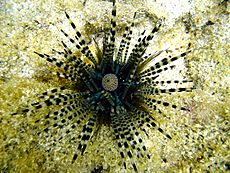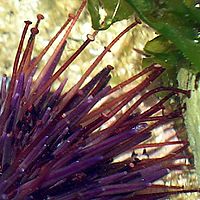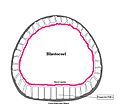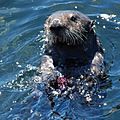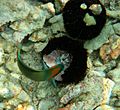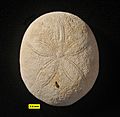Sea urchin facts for kids
Quick facts for kids Sea urchin |
|
|---|---|
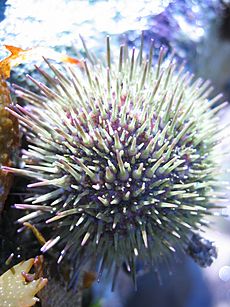 |
|
| Scientific classification | |
| Kingdom: | |
| Phylum: | |
| Class: |
Echinoidea
(sand dollars)
|
Sea urchins are the Class Echinoidea of the Phylum Echinodermata. Like the rest of the Echinoderms, literally "spike-skinned", they are entirely marine. They are usually globe-shaped, and protected by calcareous plates and spines. Urchin is an old word for hedgehog, and in many foreign languages these animals are called "sea hedgehogs".
Like other echinoderms they have five-fold symmetry (called pentamerism) and move by means of hundreds of tiny, transparent, adhesive 'tube feet'. The symmetry is not obvious in the living animal, but is easily visible in the dried test.
Sea urchins mostly feed on algae and small animals. They have a special chewing apparatus called Aristotle's lantern, after the Greek philosopher Aristotle who was fascinated by sea urchins. With this apparatus they can scrape organisms stuck to the surface over which the urchin is moving.
Contents
Spines
The spines are long and sharp in some species, and protect the urchin from predators. The spines inflict a painful wound when they penetrate human skin, but are usually not dangerous. Echinoids also have pincer-like pedicellaria all over their body between the spines. The job of these is to deal with anything (like larvae) settling on the test (outer shell). It is not known if the spines are venomous (unlike the pedicellariae between the spines, which are venomous).
Typical sea urchins have spines that are 1 to 3 centimetres (0.39 to 1.18 in) in length, 1 to 2 millimetres (0.039 to 0.079 in) thick, and not terribly sharp. Diadema antillarum, familiar in the Caribbean, has thin, potentially dangerous spines that can reach 10 to 30 centimetres (3.9 to 11.8 in) long.
Teeth
Sea urchins have five jaws with one tooth each. The teeth grow throughout the sea urchin's life. The teeth of the pink sea urchin chip against each other to stay sharp.
Ecology
Sea urchins feed mainly on algae, but can also feed on sea cucumbers, and a wide range of invertebrates such as mussels, polychaetes, sponges, brittle stars and crinoids. Sea urchins are one of the favorite foods of sea otters and wolf eels. Without predators to eat them, urchins breed in large numbers and eat almost all the nearby kelp, creating an urchin barren, devoid of macroalgae and associated fauna. Sea otters have re-entered British Columbia, dramatically improving coastal ecosystem health by eating sea urchins.
Fossil record and evolution
The first echinoid fossils are from the Lower Ordovician period. The earliest forms had flexible tests, with plates that could slide over each other. Echinoids were a relatively unimportant part of the biota in the Palaeozoic. Only one group survived the P/Tr extinction event to form the basis of all later echinoids. The group which survived into the Triassic, the Cidaroids, radiated into all other modern groups, which are known as the Euechinoids.
The break with perfect symmetry, which happened in the Jurassic, gave them definite front and back ends. This opened up new habitats, in particular, the burrowing habitat. Sand dollars and heart urchins have been highly successful. The living echinoids are now important members of the biota, especially in shallow and in-shore waters.
Sea urchins as food
Some humans eat the reproductive organs of sea urchins (which they call roe). This is popular in Korea. In Japan, this kind of sushi is called uni.
As tools
In the Pacific, bunches of heavy spines from slate-pencil urchins (Heterocentrotus species) were used as abrasion tools for shipbuilding.
Aquaria
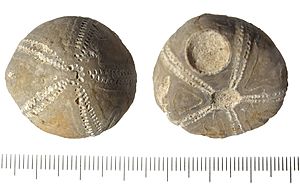
Some species of sea urchins, such as the slate pencil urchin (Eucidaris tribuloides), are commonly sold in aquarium stores. Some species are effective at controlling filamentous algae, and they make good additions to an invertebrate tank.
Folklore
A folk tradition in Denmark and southern England imagined sea urchin fossils to be thunderbolts, able to ward off harm by lightning or by witchcraft, as an apotropaic symbol. Another version supposed they were petrified eggs of snakes, able to protect against heart and liver disease, poisons, and injury in battle, and accordingly they were carried as amulets. These were, according to the legend, created by magic from foam made by the snakes at midsummer.
Images for kids
-
Pluteus larva has bilateral symmetry.
-
A sand dollar, an irregular sea urchin (Irregularia)
-
Test of an Echinodiscus tenuissimus, an irregular sea urchin ("sand dollar")
-
Wolf eel, a highly specialized predator of sea urchins
-
A sea otter feeding on a purple sea urchin.
-
A wrasse finishing the remains of a damaged Tripneustes gratilla
-
Purple sea urchins at low tide in California. They dig a cavity in the rock to hide from predators during the day.
-
Archaeocidaris brownwoodensis, Cidaroida, Carboniferous, c. 300 mya
-
Miocidaris coaeva, Cidaroida, Middle Triassic, c. 240 mya
-
Clypeus plotti, Irregularia, Middle Jurassic, c. 162 mya
-
Echinocorys, Holasteroida, Upper Cretaceous, c. 80 mya
-
Echinolampas ovalis, Cassiduloida, Middle Eocene, c. 40 mya
-
Clypeaster portentosus, Clypeasteroida, Miocene, c. 10 mya
-
Japanese uni-ikura don, sea urchin egg and salmon egg donburi
See also
 In Spanish: Erizos de mar para niños
In Spanish: Erizos de mar para niños


